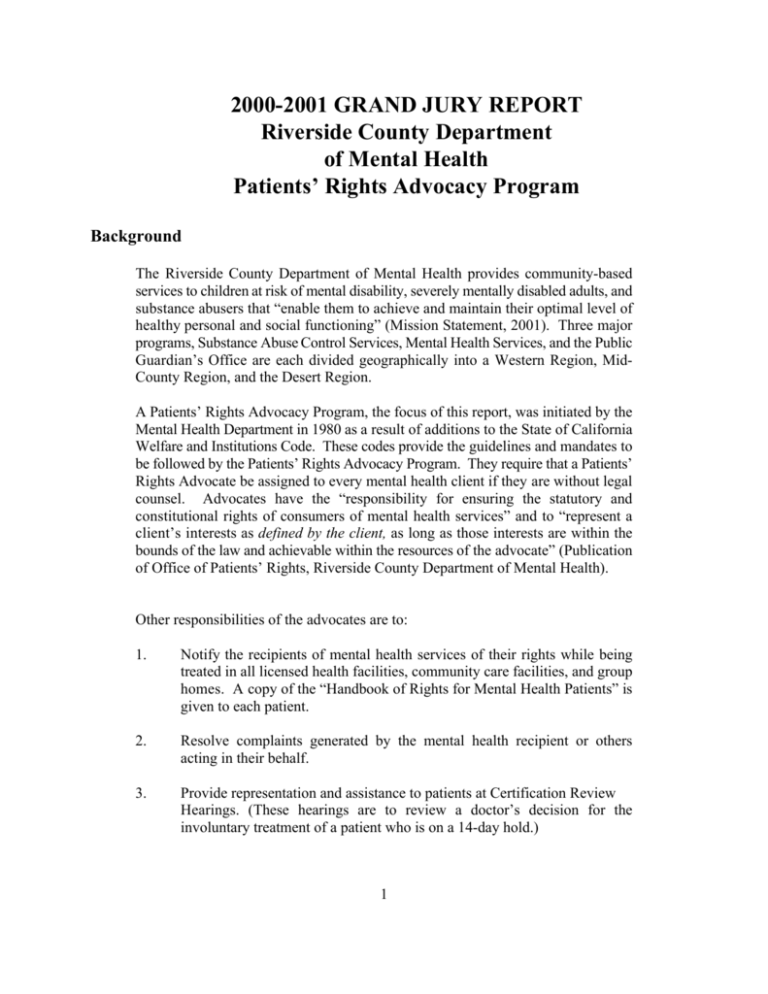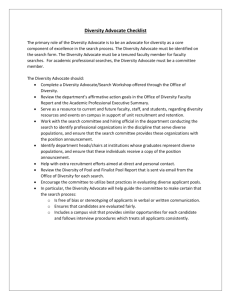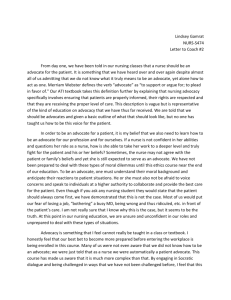Riverside County Dept of Mental Health Patients' Rights Advocacy
advertisement

2000-2001 GRAND JURY REPORT Riverside County Department of Mental Health Patients’ Rights Advocacy Program Background The Riverside County Department of Mental Health provides community-based services to children at risk of mental disability, severely mentally disabled adults, and substance abusers that “enable them to achieve and maintain their optimal level of healthy personal and social functioning” (Mission Statement, 2001). Three major programs, Substance Abuse Control Services, Mental Health Services, and the Public Guardian’s Office are each divided geographically into a Western Region, MidCounty Region, and the Desert Region. A Patients’ Rights Advocacy Program, the focus of this report, was initiated by the Mental Health Department in 1980 as a result of additions to the State of California Welfare and Institutions Code. These codes provide the guidelines and mandates to be followed by the Patients’ Rights Advocacy Program. They require that a Patients’ Rights Advocate be assigned to every mental health client if they are without legal counsel. Advocates have the “responsibility for ensuring the statutory and constitutional rights of consumers of mental health services” and to “represent a client’s interests as defined by the client, as long as those interests are within the bounds of the law and achievable within the resources of the advocate” (Publication of Office of Patients’ Rights, Riverside County Department of Mental Health). Other responsibilities of the advocates are to: 1. Notify the recipients of mental health services of their rights while being treated in all licensed health facilities, community care facilities, and group homes. A copy of the “Handbook of Rights for Mental Health Patients” is given to each patient. 2. Resolve complaints generated by the mental health recipient or others acting in their behalf. 3. Provide representation and assistance to patients at Certification Review Hearings. (These hearings are to review a doctor’s decision for the involuntary treatment of a patient who is on a 14-day hold.) 1 4. Provide representation for a patient at a Medication Capacity Hearing (Riese Hearing). (A Riese Hearing is held to determine if the patient has the mental capacity to refuse medications ordered during an involuntary treatment period.) 5. Monitor the services and programs of all licensed mental health facilities to ensure compliance with pertinent laws and regulations. 6. Provide education about patients’ rights and mental health laws to all providers of mental health services. Findings 1. The first Patients’ Rights Advocate was appointed in 1980. The current staff in the Patients’ Rights Department includes a Chief Patients’ Rights Advocate, three regular advocates, a Licensed Vocational Nurse II (LVN II), and an Office Assistant III (OA III). 2. The population of Riverside County was 1,522,855 on January 1, 2000. The 1986 State Department of Mental Health Task Force recommended a staffing ratio of 1/300,000 in the Patients’ Rights Advocates office. The current ratio is 1/500,000. 3. The Chief Patients’ Rights Advocate’s primary responsibilities are “... to plan, organize, coordinate, direct, and supervise the Administrative aspects of the Patients’ Rights Program” (Job Description of the Chief Patients’ Rights Advocate, 6/98). The Chief Advocate is currently carrying regular advocate responsibilities and spending limited time on administrative functions. 4. In February 2000, the Patients’ Rights Office was assigned the additional responsibility of attending and monitoring Riese Hearings that were formerly handled by the County Public Defenders Office. No additional staff was allocated for this purpose. Riese Hearings for a client must be held within 24 hours after filing. The Patients’ Rights Program receives a one-day notice of the hearing, which requires three hours preparation time in addition to the 15 to 60 minutes court time. If these hearings are scheduled in outlying courts, additional time is required for travel. Scheduling is difficult and on occasion a patient does not receive the required representation of the Patients’ Rights Advocate. Of the last three Riese Hearings held in Indio, the advocate was only able to represent two. In the last 12 months, an advocate represented all 80 clients in Riverside. 2 5. Three facilities are designated to receive, evaluate, and assess an individual who is on a 72-hour hold for acute care and treatment. They are the Oasis Mental Health Center in Indio, Desert Regional Medical Center in Palm Springs, and the Riverside County Regional Medical Center (RCRMC) in Moreno Valley. The RCRMC has an additional site, the Emergency Treatment Services in Riverside. The Patients’ Rights Offices are adjacent to the Emergency Treatment Services. There are also 40 licensed community care facilities that the Patients’ Rights Department oversees. 6. The current office space for the Patients’ Rights Department is inadequate Each office houses two personnel necessitating one advocate to go to another location when a client is being interviewed. They are to move on or about June 15, 2001, to a facility with cubicles and a conference room for their interviews. An office will be retained at their present location for needed onsite work. The negative issues of inadequate space and privacy will remain, with the additional problem of staffing two locations. 7. The California Welfare and Institutions Code 5520-b mandates a yearly review of Patients’ Rights Programs by an advocate at all mental health facilities. These Patients’ Rights Programs have not been reviewed for four years. 8. Advocates have been unable to maintain patients’ rights group meetings and special discussions in mental health facilities due to lack of time and personnel. 9. Mandated (Welfare and Institutions Code 5520-c) in-service education for the staff at mental health facilities was discontinued in February 2000 due to insufficient staff. 10. The File Maker Pro software has been installed in two computers but has not been programmed to meet the information and tracking needs of the department. An additional computer allocated to the department has not yet been delivered. 11. In 1994, the Office of Patients’ Rights Protection and Advocacy, Inc. conducted a Program Review of the Riverside County Patients’ Rights Program and found the previously recommended staff ratio remains unmet. 3 Recommendations Riverside County Board of Supervisors, Riverside County Department of Mental Health, and Patients’ Rights Advocacy Program 1. Immediately provide the funds necessary to increase the number of Patients’ Rights Advocates by a minimum of two to meet the standard of 1/300,000 population as recommended by the Department of Mental Health Task Force. 2. Utilize the Chief Patients’ Rights Advocate in oversight and administrative functions as opposed to routine advocate duties. 3. Provide for programming of the File Maker Pro software, training in the use of this software, and delivery of the computer allocated to the department immediately following their relocation. 4. Contract for an updated study by the Patients’ Rights Protection and Advocacy, Inc. for a review of the current Patients’ Rights Program. 4






